人教版高中英语必修二 UNIT 4 学历案设计(课件)
文档属性
| 名称 | 人教版高中英语必修二 UNIT 4 学历案设计(课件) | 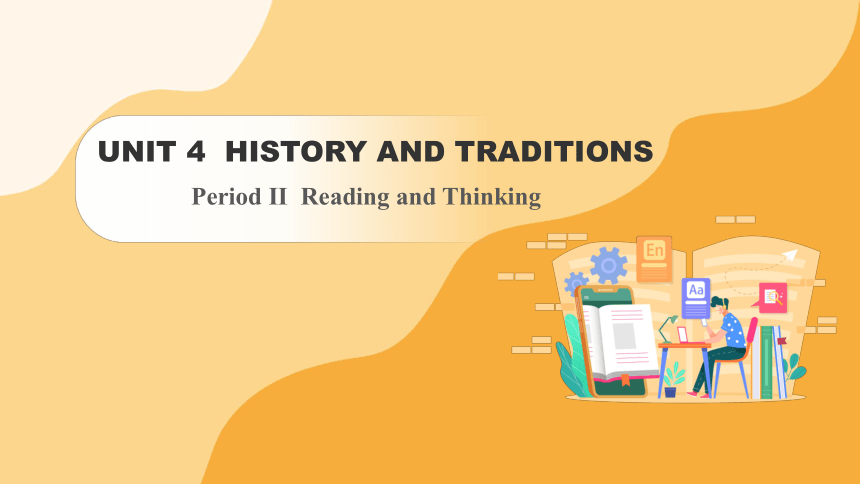 | |
| 格式 | pptx | ||
| 文件大小 | 1.9MB | ||
| 资源类型 | 试卷 | ||
| 版本资源 | 人教版(2019) | ||
| 科目 | 英语 | ||
| 更新时间 | 2023-12-06 05:58:43 | ||
图片预览

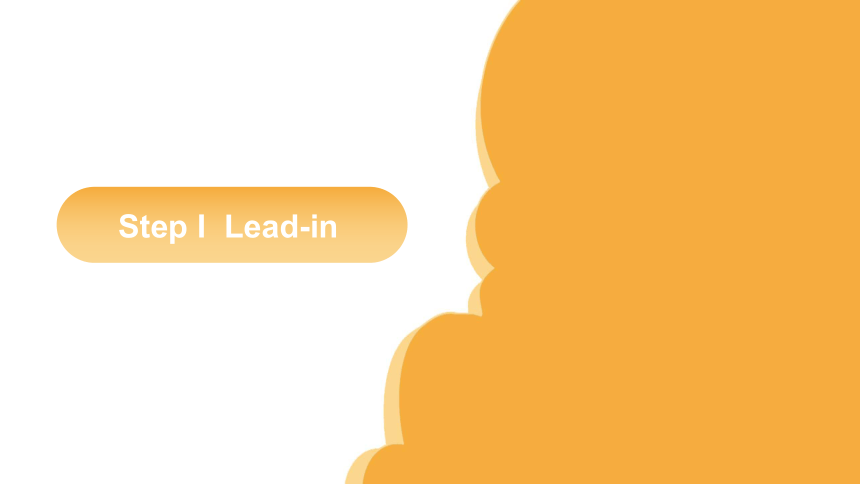
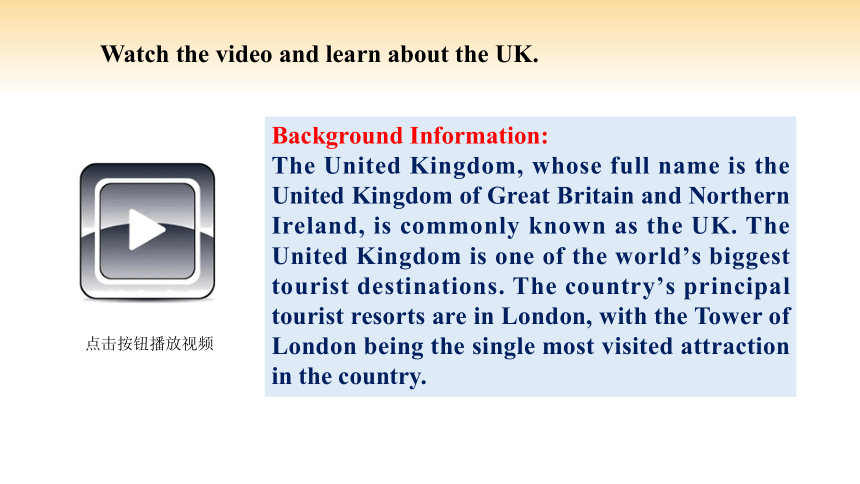

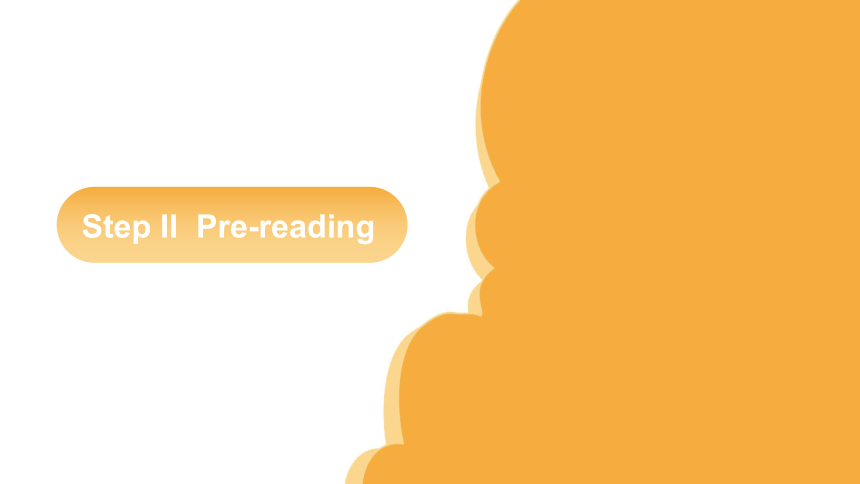
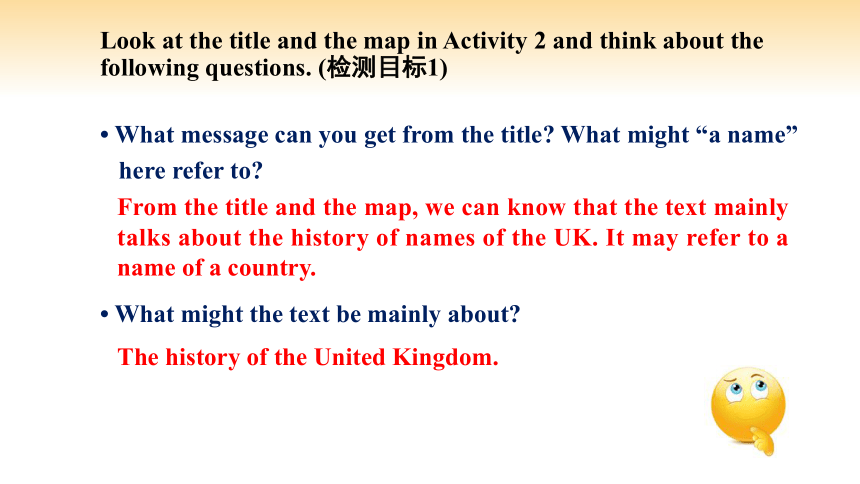
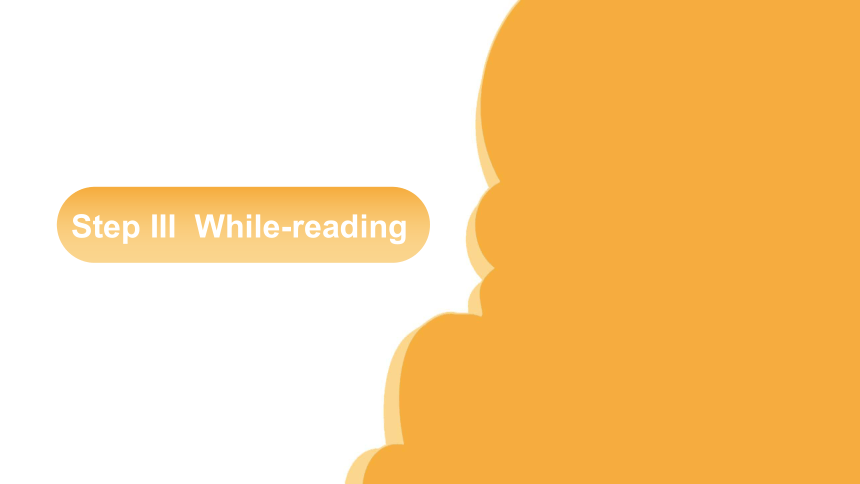
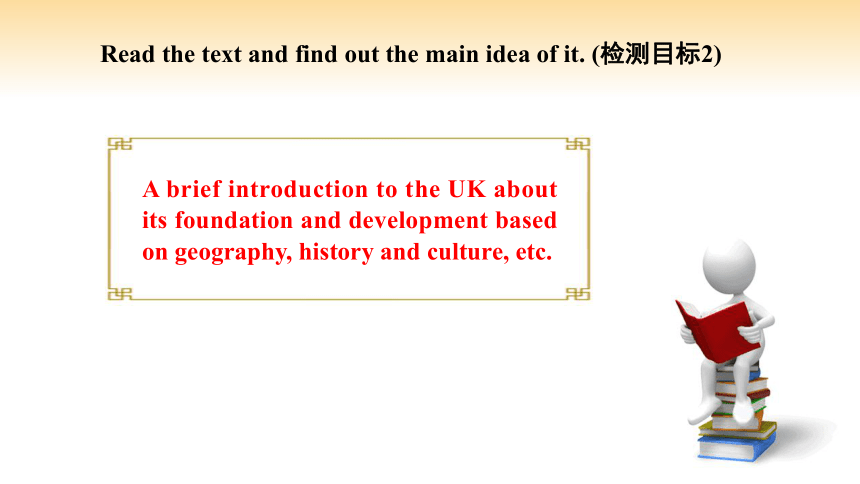
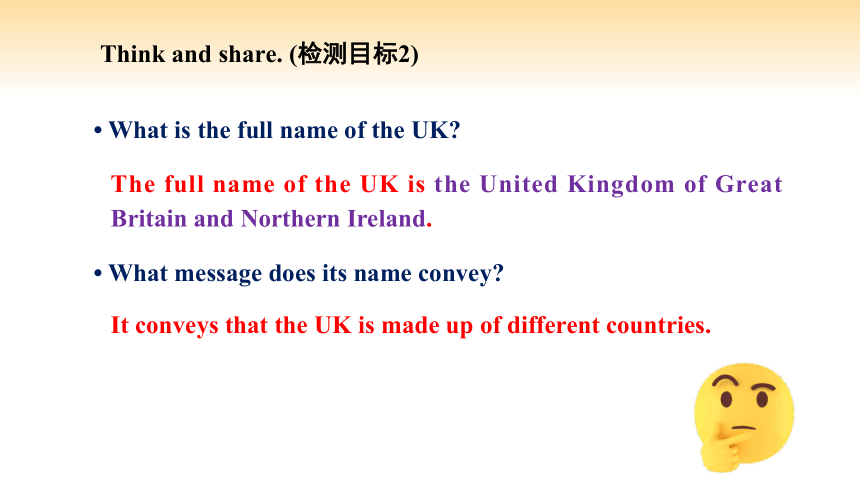
文档简介
(共24张PPT)
UNIT 4 HISTORY AND TRADITIONS
Period II Reading and Thinking
Step I Lead-in
Watch the video and learn about the UK.
点击按钮播放视频
Background Information:
The United Kingdom, whose full name is the United Kingdom of Great Britain and Northern Ireland, is commonly known as the UK. The United Kingdom is one of the world’s biggest tourist destinations. The country’s principal tourist resorts are in London, with the Tower of London being the single most visited attraction in the country.
Look at the map and discuss the following questions in pairs.
What does the map show What is it used for
What do the different symbols and colours stand for
The map shows the British Isles, the islands which make up the Great Britain (England, Scotland, and Wales) and Ireland (Ireland and Northern Ireland). It is used to show the four different countries that make up the UK and some of the major cities.
The small circles stand for big cities, the red spot stands for the capital and different colours stand for different regions or countries.
Step II Pre-reading
Look at the title and the map in Activity 2 and think about the following questions. (检测目标1)
What message can you get from the title What might “a name”
here refer to
What might the text be mainly about
From the title and the map, we can know that the text mainly talks about the history of names of the UK. It may refer to a name of a country.
The history of the United Kingdom.
Step III While-reading
Read the text and find out the main idea of it. (检测目标2)
A brief introduction to the UK about its foundation and development based on geography, history and culture, etc.
Think and share. (检测目标2)
What is the full name of the UK
What message does its name convey
The full name of the UK is the United Kingdom of Great Britain and Northern Ireland.
It conveys that the UK is made up of different countries.
Read the text again and answer the following questions. (检测目标2)
What are the countries that make up the UK
What are the similarities and differences between
these countries
They are England, Wales, Scotland and Northern Ireland.
Similarities: flag, currency and military defence.
Differences: education systems, legal systems,
traditions and football teams.
Read the text again and answer the following question. (检测目标2)
How is the text organised
The text is organised according to
the order of time.
Complete the timeline. (检测目标2)
11th
century
16th
century
18th
century
19th
century
20th
century
Romans
arrived
Anglo-Saxons came
Vikings came
1st
century
5th
century
8th
century
Normans conquered England
Wales
was
joined
Scotland
was
joined
Ireland
was
joined
the southern part of Ireland broke away
Read the text again and sort out the information according to the timeline. (检测目标3)
When What happened What changed
Romans arrived
Anglo-Saxons came
Vikings came
11th century
16th century
18th century
19th century
20th century
1st century
towns and roads
5th century
language and way houses were built
8th century
vocabulary and names of locations across the UK
Normans conquered England after the Battle of Hastings
castles built, legal system changed, and new words from French introduced
Wales was joined to Kingdom of England
Scotland was joined to England and Wales
“Kingdom of Great Britain” formed/created
Ireland was added
“United Kingdom of Great Britain and Ireland” formed/created
the southern part of Ireland broke away
name changed to “United Kingdom of Great Britain and Northern Ireland”
Step IV Post-reading
Introduce the history of the UK according to the timeline. (检测目标3)
1st century
5th century
8th century
11th century
16th century
18th century
19th century
20th century
Part 1 (Para. 1) A. Origins of the names.
Part 2 (Para. 2) B. Advantages of studying the history
of the UK.
Part 3 (Para. 3) C. Comparison of the four countries of
the UK.
Part 4 (Paras. 4~5) D. Introduction to the topic.
Match each part of the text with its main idea. (检测目标3)
1. The UK has an interesting history and rich culture.
( )
2. The history of London dates back to Anglo-Saxon times.
( )
3. The mix of history and modern culture makes the UK
attractive. ( )
Read Paragraph 5 and decide whether the following statements are true (T) or false (F). (检测目标3)
T
F
T
A: I can never remember what the UK means! There’s England, Britain, _________
Great Britain!
B: Well, it helps if you remember that there are four countries that ___________ the
UK. That’s why it’s called the United Kingdom.
A: Four countries I must have been asleep in that part of our history class! So the
first country was England, and the others were _________ that
B: Yes, right. First England, then Wales, then Scotland. The last country was Ireland,
but later the southern half didn’t want to be __________ the United Kingdom.
A: Oh, I remember now! The southern part ______________ from Northern Ireland,
right
B: Yes, you got it well remembered! But ____________________ in history class next
time!
Complete the conversation about the UK using the phrases in their correct forms. (检测目标3)
as well as belong to add to join to break away keep your eyes open
as well as
belong to
added to
joined to
broke away
keep your eyes open
Discuss the question below in groups. (检测目标4)
What are the two chief advantages of studying the history of a
country
The two chief advantages of studying the history of a country are to help you understand more about the country and its traditions and to make your visit more enjoyable.
Write a summary of the text according to the clues. (检测目标4)
Wales, Scotland, Ireland, break away, the Romans, the Anglo-Saxons,
the Vikings, the Normans, London
In the 16th century, Wales became part of the Kingdom of England. Later Scotland joined, which created the Kingdom of Great Britain. The addition of the Kingdom of Ireland created the United Kingdom of Great Britain and Ireland. The breaking away of the southern part of Ireland in the 20th century resulted in the United Kingdom of Great Britain and Northern Ireland, which most people call the UK, Britain or Great Britain.
In the UK, evidence of four ancient groups of peoples can be found. The Romans in the 1st century built towns and roads. Afterwards the Anglo-Saxons introduced the beginnings of the English language. Then the Vikings brought new vocabulary and the names of many locations. Lastly, the Normans in the 11th century built castles, changed the legal system and brought French words into the English language. A good place to start learning about the UK’s history is London, where past and present meet.
检 测 练 习
Finish the following tasks.
(1)Turn the text into the blanks filling or draw a mind map of the
basic information. (检测目标2)
(2)Design a dialogue about the main idea. (检测目标2)
Retell the text. (以下形式均可,选一种即可)
Make a booklet for foreign visitors coming to China with contents below. (检测目标3和4)
What important things should they know about before they come
to China
What do they need to pay attention to in order to avoid cultural
conflict
How can they find information about Chinese culture on the
Internet
学 后 反 思
Think about the following questions.
Can you draw a timeline of the history of UK
What reading strategies can you acquire from the text
What are your puzzles while reading
What help would you like to get from your teacher
UNIT 4 HISTORY AND TRADITIONS
Period II Reading and Thinking
Step I Lead-in
Watch the video and learn about the UK.
点击按钮播放视频
Background Information:
The United Kingdom, whose full name is the United Kingdom of Great Britain and Northern Ireland, is commonly known as the UK. The United Kingdom is one of the world’s biggest tourist destinations. The country’s principal tourist resorts are in London, with the Tower of London being the single most visited attraction in the country.
Look at the map and discuss the following questions in pairs.
What does the map show What is it used for
What do the different symbols and colours stand for
The map shows the British Isles, the islands which make up the Great Britain (England, Scotland, and Wales) and Ireland (Ireland and Northern Ireland). It is used to show the four different countries that make up the UK and some of the major cities.
The small circles stand for big cities, the red spot stands for the capital and different colours stand for different regions or countries.
Step II Pre-reading
Look at the title and the map in Activity 2 and think about the following questions. (检测目标1)
What message can you get from the title What might “a name”
here refer to
What might the text be mainly about
From the title and the map, we can know that the text mainly talks about the history of names of the UK. It may refer to a name of a country.
The history of the United Kingdom.
Step III While-reading
Read the text and find out the main idea of it. (检测目标2)
A brief introduction to the UK about its foundation and development based on geography, history and culture, etc.
Think and share. (检测目标2)
What is the full name of the UK
What message does its name convey
The full name of the UK is the United Kingdom of Great Britain and Northern Ireland.
It conveys that the UK is made up of different countries.
Read the text again and answer the following questions. (检测目标2)
What are the countries that make up the UK
What are the similarities and differences between
these countries
They are England, Wales, Scotland and Northern Ireland.
Similarities: flag, currency and military defence.
Differences: education systems, legal systems,
traditions and football teams.
Read the text again and answer the following question. (检测目标2)
How is the text organised
The text is organised according to
the order of time.
Complete the timeline. (检测目标2)
11th
century
16th
century
18th
century
19th
century
20th
century
Romans
arrived
Anglo-Saxons came
Vikings came
1st
century
5th
century
8th
century
Normans conquered England
Wales
was
joined
Scotland
was
joined
Ireland
was
joined
the southern part of Ireland broke away
Read the text again and sort out the information according to the timeline. (检测目标3)
When What happened What changed
Romans arrived
Anglo-Saxons came
Vikings came
11th century
16th century
18th century
19th century
20th century
1st century
towns and roads
5th century
language and way houses were built
8th century
vocabulary and names of locations across the UK
Normans conquered England after the Battle of Hastings
castles built, legal system changed, and new words from French introduced
Wales was joined to Kingdom of England
Scotland was joined to England and Wales
“Kingdom of Great Britain” formed/created
Ireland was added
“United Kingdom of Great Britain and Ireland” formed/created
the southern part of Ireland broke away
name changed to “United Kingdom of Great Britain and Northern Ireland”
Step IV Post-reading
Introduce the history of the UK according to the timeline. (检测目标3)
1st century
5th century
8th century
11th century
16th century
18th century
19th century
20th century
Part 1 (Para. 1) A. Origins of the names.
Part 2 (Para. 2) B. Advantages of studying the history
of the UK.
Part 3 (Para. 3) C. Comparison of the four countries of
the UK.
Part 4 (Paras. 4~5) D. Introduction to the topic.
Match each part of the text with its main idea. (检测目标3)
1. The UK has an interesting history and rich culture.
( )
2. The history of London dates back to Anglo-Saxon times.
( )
3. The mix of history and modern culture makes the UK
attractive. ( )
Read Paragraph 5 and decide whether the following statements are true (T) or false (F). (检测目标3)
T
F
T
A: I can never remember what the UK means! There’s England, Britain, _________
Great Britain!
B: Well, it helps if you remember that there are four countries that ___________ the
UK. That’s why it’s called the United Kingdom.
A: Four countries I must have been asleep in that part of our history class! So the
first country was England, and the others were _________ that
B: Yes, right. First England, then Wales, then Scotland. The last country was Ireland,
but later the southern half didn’t want to be __________ the United Kingdom.
A: Oh, I remember now! The southern part ______________ from Northern Ireland,
right
B: Yes, you got it well remembered! But ____________________ in history class next
time!
Complete the conversation about the UK using the phrases in their correct forms. (检测目标3)
as well as belong to add to join to break away keep your eyes open
as well as
belong to
added to
joined to
broke away
keep your eyes open
Discuss the question below in groups. (检测目标4)
What are the two chief advantages of studying the history of a
country
The two chief advantages of studying the history of a country are to help you understand more about the country and its traditions and to make your visit more enjoyable.
Write a summary of the text according to the clues. (检测目标4)
Wales, Scotland, Ireland, break away, the Romans, the Anglo-Saxons,
the Vikings, the Normans, London
In the 16th century, Wales became part of the Kingdom of England. Later Scotland joined, which created the Kingdom of Great Britain. The addition of the Kingdom of Ireland created the United Kingdom of Great Britain and Ireland. The breaking away of the southern part of Ireland in the 20th century resulted in the United Kingdom of Great Britain and Northern Ireland, which most people call the UK, Britain or Great Britain.
In the UK, evidence of four ancient groups of peoples can be found. The Romans in the 1st century built towns and roads. Afterwards the Anglo-Saxons introduced the beginnings of the English language. Then the Vikings brought new vocabulary and the names of many locations. Lastly, the Normans in the 11th century built castles, changed the legal system and brought French words into the English language. A good place to start learning about the UK’s history is London, where past and present meet.
检 测 练 习
Finish the following tasks.
(1)Turn the text into the blanks filling or draw a mind map of the
basic information. (检测目标2)
(2)Design a dialogue about the main idea. (检测目标2)
Retell the text. (以下形式均可,选一种即可)
Make a booklet for foreign visitors coming to China with contents below. (检测目标3和4)
What important things should they know about before they come
to China
What do they need to pay attention to in order to avoid cultural
conflict
How can they find information about Chinese culture on the
Internet
学 后 反 思
Think about the following questions.
Can you draw a timeline of the history of UK
What reading strategies can you acquire from the text
What are your puzzles while reading
What help would you like to get from your teacher
